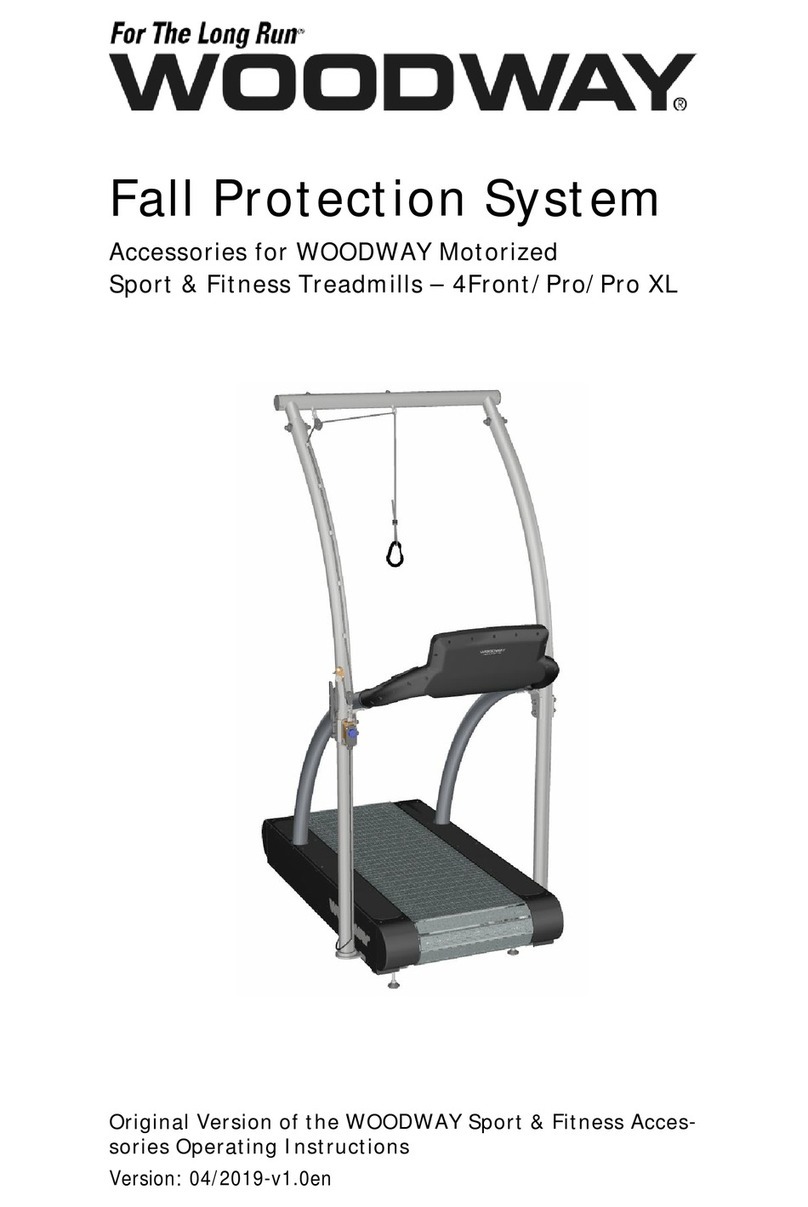
07.12.23 UM-EN-V1
8
WARNING - To reduce the risk of injury to you and others:
• Dynamic Mode- The treadmills have the ability to be used in a free-wheel (non-motorized) mode. This
allows the user to manually control the speed of the belt and disengages the belt. Never leave the
treadmill in Dynamic Mode, as users unaware of freewheel mode may inadvertently accelerate the belt.
• If the treadmill is stopped while in use at an incline (e.g. emergency stop switch ac-activated, safety
lanyard pulled, loss of power, etc.) the belt may freewheel. The user’s weight and gravity can lead to
inadvertent belt acceleration.
• Always press the STOP button to end the workout.
• Never leave the treadmill unattended while a workout is in progress.
• Set up and operate the treadmill on a solid, level surface.
• Use the treadmill only for its intended purpose as described in the manual.
• Do not use attachments not specified by the manufacturer.
• The treadmill should never be left unattended when plugged in. Unplug the treadmill from the outlet
when not in use and before cleaning or servicing.
• Do not operate the treadmill outside.
• To disconnect the treadmill, turn all controls to OFF position then remove the plug from the outlet.
• Connect the treadmill to a properly grounded outlet only. See Grounding Instructions.
• Keep all loose clothing and towels away from the running surface. It is also important that shoe laces do
not extend beyond the bottom of the shoe.
• Keep the area behind treadmill clear and at least 78” (2 m) from walls or furniture.
• Keep hands away from all moving parts.
• Never leave children unsupervised while on or near the treadmill.
• Inspect the treadmill for worn or loose components prior to use. Tighten or replace any worn or loose
components prior to use.
• Read, understand, and test all emergency stop procedures.
• Always use the emergency safety pull cord supplied with the treadmill. It can be clipped to an article of
clothing while training. This is for the user’s safety in case of an emergency.
• WOODWAY treadmills are built to handle runners weighing up to 800 lbs. (360 kg) at speeds between 0-4
MPH (0-6.5 km/h) and 400 lbs. (180 kg) at speeds greater than 4MPH (6.5 km/h).
• The treadmill running belt might not stop immediately if an object becomes caught in the belt or rollers.
• WOODWAY recommends that facilities utilizing high speed/over-speed training applications or special
applications, or those that have users who are elderly, are children, or have health limitations, use a
safety gantry harness. The manufacturer declines any liability for personal injury and/or property
damage which could have been avoided with the use of a gantry harness system.
• Care should be taken when mounting and dismounting the treadmill. Never mount or dismount the tread-
mill while the running belt is moving. Use the handrails and handlebar whenever practical or necessary.
• Wear proper athletic shoes with rubber or high-traction soles. Do not use shoes with heels or leather
soles. Ensure no stones are embedded in the profile of the soles.
• Allow several minutes to bring your heart rate into the training zone depicted in the manual. Walk slowly
after your workout to allow your body sufficient time to cool down and your heart rate to decrease.
• The safety and integrity designed for the machine can only be maintained when the treadmill is regularly
examined for damage and/or wear and repaired if necessary. It is the sole responsibility of the user/
owner or facility operator to ensure that regular maintenance is performed. Worn or damaged compo-
nents should be replaced immediately or the treadmill should be removed from service until the repair
is made. Only manufacturer supplied or approved components should be used to maintain and
repair the treadmill. SAVE THESE INSTRUCTIONS




























